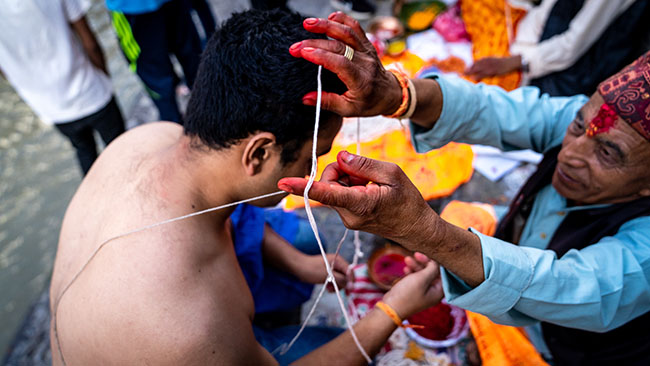Nepal witnessed a vibrant celebration of three significant festivals yesterday: Rishi Tarpani, Raksha Bandhan, and Janai Purnima. The day was filled with traditional rituals, beginning with ritual baths and followed by the changing of the sacred thread, “Janai,” and the ceremonial tying of protective threads, known as “Doro.”
These festivals, deeply rooted in ancient mythology, hold great religious significance. The festival of Janai Purnima also referred to as “Shrawani Snan,” traces its origins to the Satya Yuga. As per religious scriptures, Guru Brihaspati devised a protective ritual to shield the gods from the mighty demon king Bali. The ritual involves tying a protective thread, and reciting the chant “Yen Baddho Baliraja Danavendro Mahabal,” symbolizing protection and safety for the wearer. This tradition was explained by Professor Dr. Devmani Bhattarai, a member of the Nepal Panchang Nirnayak Samiti.
Brahmin priests across the country observed this day by tying the sacred Doro around the wrists of devotees while chanting Vedic mantras, a practice believed to ensure protection. After the ritual baths, devotees offered prayers to the seven great sages, known as Saptarishis—Kashyapa, Atri, Bharadvaja, Gautama, Jamadagni, Vashishta, and Vishvamitra. This offering, known as Rishi Tarpani, is the reason behind the festival’s name.
The Janai, or sacred thread, is a powerful symbol of knowledge. Its strands represent the trinity of Brahma, Vishnu, and Maheshwar, while the second set of strands signifies the triad of action, devotion, and knowledge, reflecting the principles of the Vedic Guru tradition.
A special dish, “Kwati,” made from a blend of 11 types of sprouted lentils, is traditionally prepared and consumed on this day. Kwati is believed to have medicinal properties, helping to prevent illness, cleanse the digestive system, and provide warmth during the monsoon season, especially for those involved in agricultural work.
In the Terai region, the festival of Raksha Bandhan was celebrated with sisters tying Rakhi around their brothers’ wrists, symbolizing love and protection. This custom, originally practiced in the Terai, has now gained popularity in the Kathmandu Valley and other hilly areas.
Religious fairs were held at several sacred sites, including Pashupatinath, Gokarneshwar, Doleswar, Santaneshwar, and Manichud, as well as at holy ponds and lakes like Gosainkunda in Rasuwa, Kumbheshwar in Lalitpur, Panch Pokhari in Sindhupalchok, and Trivenidham in Nawalparasi. Devotees flocked to these sites to take part in the religious observances.
The Newar community marked the day with the celebration of “Gunhu Punhi.” This festival, closely associated with the tradition of eating Kwati, is believed to have originated from Newar culture. The day also saw the Newar people performing a unique ritual to worship frogs, in gratitude for their role in protecting humanity by defeating the demon Ghantakarna.
Followers of Buddhism also observed the day as a commemoration of Lord Gautama Buddha’s triumph over desire. This significant event, detailed in the Buddhist scripture Lalitavistara Sutra, is marked by a special fair at Swyambhunath.






